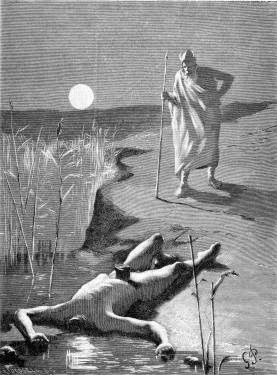Óðinn with Mímir's body, illustration by Georg Pauli (1893)
(public domain)
The Vanir were the Nordic people living in Northern Europe. They knew about all the land on the planet including America because they travelled with their boats. Some called Europe, Enea. The Aesir was the Cronide family and their capital was Asgard or Asgarth. I am still debating whether this was Zeus-Odin's home in Crete or Mt. Olympus since the Asgard was eventually destroyed.
The war between the Vanir and Aesir went on for a long time and both sides could not defeat the other. Finally, they made a truce and people were exchanged. Njordr and his wife and children Freyr and Freyja were given to Odin-Zeus. Another wise man named Kvasir was given to the Aesir.
In exchange, the Aesir gave the Vanir a tall handsome man named Hoenir. Another wise man named Mimir was given to the Vanir. When the Vanir figured out that Hoenir was not that smart and needed the council of Mimir to make decisions, they beheaded Mimir and sent his head back to Odin-Zeus. Here is what Snorri Sturluson wrote:
Then the Vanir suspected that the Aesir had defrauded them in the exchange of hostages. Then they seized Mimir and beheaded him and sent the head to the Aesir. Othin took it and embalmed it with herbs so that it would not rot, and spoke charms over it, giving it magic power so that it would answer him and tell him many occult things. - Snorri Sturluson - Heimskringla - page 8.
The saga continues on with Freyja teaching the Aesir magic and the tales of Odin travelling for many years.
Then he set his brothers Ve and Villi over Asgarth, but he himself and all diar, and many other people, departed. First he journeyed west to Garthariki [Russia], and then south, to Saxland [Northwestern Germany]. He had many sons. He took possession of lands far and wide in Saxland and set his sons to defend these lands. Then he journeyed north to the sea and fixed his abode on an island. That place is now called Othinsey [Othin's Island], on the island of Funen. - Snorri Sturluson - Heimskringla - page 9.
Odin went to Northeastern Europe and taught the people many skills. He was said to be handsome and charming but in war absolutely merciless. He spoke in rhymes and established the Beserker rage.
Odin was also said to be very skilled in magic and could shape-shift. He could extinguish fires with his words:
He was also able with mere words to extinguish fires, to calm seas, and turn the winds any way he please. He had a ship called Skithblathnir with which he sailed over great seas. It could be folded together like a cloth.
Othin had with him Mimir's head, which told him many tidings from other worlds; and at times he would call to life dead men out of the ground, or he would sit down under men that were hanged. On this account he was called Lord of Ghouls of the hanged. He had two ravens on whom he had bestowed the gift of speech. They flew far and wide over the lands and told him many tidings. By these means he became very wise in his lore. And all these skills he taught with those runes and songs which are called magic songs [charms]. For this reason the Aesir are called Workers of Magic.
- Snorri Sturluson - Heimskringla - pages 10-11.
Now, I have just revealed that Odin-Zeus was a "Worker of Magic" or a magician. Where do you think King Solomon and the Secret Societies get their teachings from?
George Bush in Skull and Bones (fair use title 17 section 107)
Do you see the skull in the above picture? This represents the magical skull of Mimir (used for Necromancy). The clock represents the Cronide bloodline (Cronus is not only the God of the Air, but the God of time). The legs are positioned to represent the Freemasonic Square and Compass (which also forms part of the Cronide bloodline Tree of Life and Tree of Death from Kabbalah) and these people above practice Sorcery (which probably includes blood sacrifice as Jews are doing today and have done in their "Cult of Jupiter Sabazios"). These ancient rituals go back to Odin-Zeus and his mystery schools that he and the rest of the Cronides established. Is it any wonder why I can't get interviews from mainstream or alternative media? Both are controlled. From a site about ritual Jewish sacrifice:
Types of Karbanot
There are many different types of Karbanot, and the laws related to them are detailed and complicated. This section introduces some of the major types of Karbanot - there are many subtypes within these classifications and other types that do not fit into these categories.Olah: Burnt Offering
Perhaps the best-known class of offerings is the burnt offering. It was the oldest and commonest sacrifice, and represented submission to G-d's will. The Hebrew word for burnt offering is olah, from the root Ayin-Lamed-Heh, meaning ascension. It is the same root as the word aliyah, which is used to describe moving to Israel or ascending to the podium to say a blessing over the Torah. An olah is completely burnt on the outer altar; no part of it is eaten by anyone. Because the offering represents complete submission to G-d's will, the entire offering is given to G-d (i.e., it cannot be used after it is burnt). It expresses a desire to commune with G-d, and expiates sins incidentally in the process (because how can you commune with G-d if you are tainted with sins?). An olah could be made from cattle, sheep, goats, or even birds, depending on the offerer's means.
by Rita Jean Moran (www.thelibrarykids.com and www.hiddenhumanstory.com)
http://en.wikipedia.org/wiki/Square_and_Compasses
http://en.wikipedia.org/wiki/M%C3%ADmir
http://en.wikipedia.org/wiki/%C3%86sir-Vanir_War
https://www.jewishvirtuallibrary.org/jsource/Judaism/qorbanot.html



No comments:
Post a Comment